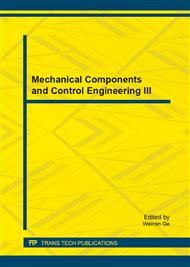[1]
Hwarng H B, Xie Na. Understanding supply chain dynamics: A chaos perspective [J]. European Journal of Operational Research, 2007, 3: 123-144.
DOI: 10.1016/j.ejor.2006.12.014
Google Scholar
[2]
Hau L Lee, V Padmanabhan, Seungjin Whang. Information distortion in supply chain, The Bullwhip Effect [J]. Management Science, 1997, 43(4): 546-556.
DOI: 10.1287/mnsc.43.4.546
Google Scholar
[3]
Hau L Lee, K C So, Tang. The value of information sharing in a two-leve1 supply chain[J], Management Science, 2003, 9: 30-35.
Google Scholar
[4]
Hoberg K, Bradley J R. Analyzing the effect of the inventory policy on order and inventory variability with linear control theory[J]. European Journal of Operational Research, 2007, 176: 1620-1642.
DOI: 10.1016/j.ejor.2005.10.040
Google Scholar
[5]
Chen Frank, Drezner Zvi, Ryan K Jennifer, Simchi-Levi David. Quantifying The Bullwhip Effect In A Simple Supply Chain: The Impact Of Forecasting, Lead Times, And information [J]. Management Science, 2000, 46(3): 436-443.
DOI: 10.1287/mnsc.46.3.436.12069
Google Scholar
[6]
Disney S M, Towill D R. On the equivalence of control theoretic, differential, and difference equation approaches to modeling supply chains [J]. Int. J. Production Economics, 2006, 101: 194-208.
DOI: 10.1016/j.ijpe.2005.05.002
Google Scholar
[7]
Luong H T, Phien N H. Measure of bullwhip effect in supply chains: The case of high order autoregressive demand process [J]. European Journal of Operational Research, 2007, 183: 197-209.
DOI: 10.1016/j.ejor.2006.09.061
Google Scholar
[8]
Peng Zhi-zhong. The Application on neural network technology in the supply chain demand prediction[J]. China Business and Market. 2007, 12: 15-17.
Google Scholar
[9]
Feng Yun, Ma Jun-hai. Nonlinear method research on demand for supply chain[J]. Journal of Beijing Institute of Technology. 2008, 10(5): 82-86.
Google Scholar
[10]
Cai Jian-feng, YANG Min. Optimal model of multi-Agent supply chain demand forecasting based on genetic algorithm [J]. Industrial Engineering Journal. 2006, 9(5): 81-85.
Google Scholar
[11]
Li Hou-Qiang, Wang Fu-Quan. Fractal theory and its application in molecular science [M]. Beijing: science press, (1993).
Google Scholar
[12]
Turcotte D L. Fractals and chaos in geology and geophysics [M]. Cambridge University Press, (1992).
Google Scholar
[13]
Fu Yu-hua. Fractal dimension and fractals in ocean engineering[J]. China Ocean Engineering, 1994, 8(3).
Google Scholar


